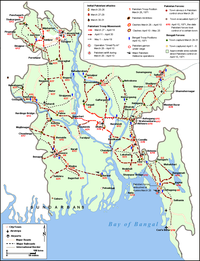| Operation Barisal | |||||||
|---|---|---|---|---|---|---|---|
| Part of Operation Searchlight and Bangladesh Liberation War | |||||||
| |||||||
| Belligerents | |||||||
| Commanders and leaders | |||||||
| Captain Ejaz Chaudhri | Colonel M. A. G. Osmani | ||||||
| Units involved | |||||||
| 17th Naval Gun Boat Squadron 8th SEALs, SSG(N) 22nd Frontier Force Regiment 6th Punjab Regiment 14 Squadron Tail choppers | Bangali Riverine Units | ||||||
| Strength | |||||||
| 4 gunboats 1 destroyer 1 patrol boat 24 fighter jets | |||||||
| Casualties and losses | |||||||
| 23 wounded | unknown | ||||||
| Further information, see Operation Searchlight, Bangladesh Liberation War and the Indo-Pakistani War of 1971 | |||||||
Background
The Barisal city of Bay of Bengal served as the command and control center for the dissident Pakistan Armed Forces units. On March 26, 1971, the Pakistan Army's 14th, 16th, and 9th Infantry Division began the Operation Searchlight, under the command of Lieutenant-General Amir Abdullah Khan Niazi, the commander of Eastern Military Command. It was the part of Operation Searchlight which was led by the Army. Meanwhile, the Bangli units were well dug in all over East Pakistan waging urban and rural riverine areas.[3]The Army had faced logistics failure, and the army was unable to eliminate the Bengali units from the Barisal City. On April 25, Pakistan Navy launched "Operation Barisal" under the command of Eastern Naval Command's commander Rear-Admiral Mohammad Shariff, who was the lead planner of the operation.[4] The Pakistan Navy began its operation under the commanding officer (Operation Barisal) Captain Ejaz Choudhry, with the support of Major Raja Nadir Pervez of 6th Amphibious Company, 6th Punjab Regiment, Major John Harris of 22nd Frontier Force Regiment, and Squadron Leader (Major) Parvaiz Mehdi Qureshi of 14th Squadron Tail Choppers , Pakistan Air Force.[5]
Firefight
Rear-Admiral Mohammad Shariff, commander of Eastern Naval Command, had coordinated the operation from Dacca, East-Pakistan.[6][7] The naval gun boats, PNS Rajashahi, and PNS Jessore were dispatched Narayanganj at full speed to embark troops. On April 24, the first gun boat arrived and commenced embarking the first naval team 8th SEALs, SSG(N). It was followed by the deploying of 6th Infantry Company, Punjab Regiment. At the same time, PNS Comilla and PNS Titumir at Khulna in the west commenced embarking troops of 22nd Frontier Force Regiment.[8]Pakistan's Brown-water navy was tasked with to transport the troops/equipment of the SSG(N) and infantry regiments to the area of operations and to land them at a suitable site on the outskirts of Barisal.[9]
The operation was began first by the 8th SSG(N) team, and commenced at 08:45 hours on April 26, 1971. The OTC Commander I. A. Khan, boarded on PNS Jessore, led the 8th SSG(N) team.[10] It was followed by the disembarking the 6th Company, Punjab Regiment. Around 0900, Comilla began to disembark the troops. Soon after the naval and infantry troops entered the city, the sporadic gun battle was insued and the attack was later followed by morter attacks. The Navy gun boats provided an effective fire power to overcome the resistance. Jessore and PNS Rajshahi commenced patrolling the south-west and north-east river approaches towards Barisal, while PNS Comilla proceeded to disembark the army troops embarked on her and the accompanying craft.[11]
During the battle, Rajashahi came under the attack, and its Commanding Officer Lieutenant A. Qayyum Khan was hit. The Executive officer Lieutenant CD Bhatti returned the fire upon the target, and members of Bengali units were seen jumping overboard towards the disengaged river bank side. Lieutenant Bhatti was unable to contact Commander IA Khan, and Major Nadir. Lt. Bhatti decided to walk where the troops were landed, with no maps, Lt. Bhatti followed general direction towards which the troops had headed.
At 1400 hours, the rendezvous was achieved and, after two hours passed, Major Nadir was informed about the attack on Rajashahi. The OTC AQ Khan was immediately taken to the military hospital from Mil Mi-8 helicopter.
After days of fighting, the Pakistani naval and infantry forces slowly advanced, but cautiously toward the city. The teams were spread all over the area, under the command of Commander IA Khan. The troops entered the city of Barisal in an evening. The infantry teams had took over the police station, while the SSG(N) team had liberated the premises of the local jail and a school where members of Bengali units had been holding pro-Pakistani elements hostage.
Following unit commanders also served in operation Barisal.
- Captain Ejaz Choudhry - Commanding officer of Operaton Barisal.[12]
- Commander I.A. Khan - Commanding officer of SEALs Team 8th, SSG(N).[13]
- Major Raja Nadir Pervez - Commanding officer of 6th company, 6th Punjab Regiment.[14]
- Major John Harris - Commanding officer of 22nd FF Company, Frontier Force Regiment.[15]
- Squadron Leader (Major) PQ Mehdi, Commanding officer of 14 Squadron Tail choppers.[16]
- Lieutenant AQ Khan - Commanding officer of PNS Rajshahi
- Lieutenant C. D. Bhatti - Commanding officer of PNS Comilla
- Lieutenant Ejaz Rasool - Commanding officer of PNS Titumir



No comments:
Post a Comment